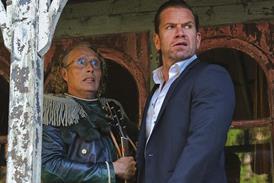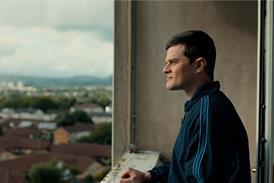The acclaimed Korean genre filmmaker talks to Ian Sandwell about his English language directorial debut The Last Stand which also marks Arnold Schwarzenegger’s solo return to the big screen.
Having made his name with acclaimed genre outings such as A Tale of Two Sisters, The Good, The Bad, The Weird and I Saw The Devil, The Last Stand marks Kim Jee-woon’s English language directorial debut as well as governing him with the task of overseeing Arnold Schwarzenegger’s solo return to the big screen.
The tale of a small town sheriff (Schwarzenegger) who becomes the last line of defence in stopping a drug lord crossing the Mexican border, The Last Stand disappointed with a $7.2m US debut this past weekend. But is just beginning its international rollout, with openings in the likes of the UK [Jan 24] and Germany [Jan 31] to come. Lionsgate handle international sales.
Can you tell us how you got involved in the project?
Lionsgate and Lorenzo di Bonaventura saw my Korean Western-style film The Good, The Bad, The Weird, and probably felt that I would be right for The Last Stand, which could be classified as a modern Western. The two films are similar in the sense that Good, Bad, Weird is about outlaws racing through the great plains to reach a goal, while The Last Stand is about a sheriff trying to stop an outlaw in a supercar racing to a destination.
Was there a particular reason behind choosing now as the time to make your Hollywood debut?
Ever since A Tale of Two Sisters (which has been remade in the US), I have been receiving many offers from Hollywood. Unfortunately, most of the projects I was offered were horror films or already packaged projects that were ready to go, and I was not interested in these. On top of that, timing was not opportune due to the projects I was working on in Korea. Then right after The Good, The Bad, The Weird, I received the offer for The Last Stand. I felt that the timing was perfect, and also I was given the opportunity to work with the writer from the beginning of development, so I decided that The Last Stand would be my Hollywood debut.
Did you notice any major differences between shooting a film in the US as opposed to Korea?
The whole system in itself is very different. In Korea, when a director makes a decision, that decision is immediately put into action. A director has that much power in Korea. In Hollywood however, the studio and the producer have as much authority as the director does, so the three must work together in the decision-making process.
Also, an assistant director in Korea is someone who supports the director and makes sure that the director’s thoughts and artistic vision is reflected within the film. Basically, the AD is the director’s closest ally, and also has the ability to make decisions on behalf of the director.
However, it seems to me that the main role of the assistant director in Hollywood is to maintain the efficiency of the production. I felt more lonesome as a director here because of that fact. At the same time though, I have learned to make more prudent decisions in this new environment.
Another difference would be the existence of strong unions and their strict rules, especially regarding time. There were so many more rules to follow compared to Korea, and now I have new found respect for the US based directors who are able to create excellent films despite the constant burden and pressure of following these rules.
In the end, a victory is only meaningful when all the rules of the game have been followed. I must admit that initially, I was shaken a bit from being in a totally unfamiliar environment, but I’ve began to understand the system in the process and feel more comfortable in it now. By the end of the film, I was able to use my ability to the fullest.
How important was it to have someone you’d already worked with, in Ji-Yong Kim, on set while you were making this film?
It was my first film in Hollywood, so I absolutely needed a few people who I have worked with before. I had Ji-Yong Kim as the director of photography during production and Mowg as the composer during post-production. The two have helped me out tremendously through the process. I was especially encouraged by their confidence and fearlessness in this foreign environment.
One of the most pleasing aspects for me was the use of practical stunts, especially in the car chases, how difficult was it to shoot those sequences? Were there any major problems?
We have a car chase scene that takes place inside a vast cornfield. A snowstorm hit Albuquerque few weeks before the cornfield shoot, completely covering our cornfield with heavy snow. We were concerned that we wouldn’t be able to shoot this scene at all, and actually looked into cornfields in other areas. Fortunately, the snow melted away just in time, and the cornfield had a nice golden hue to it. Not only that, the cornstalks had become flimsier which made it a bit easier for the cars to drive over.
We did lose some parts of the field, so we had to be very frugal with the use of corn. It was almost as if we were giving the cornfield a nice shave using our cars as razor blades. In the end, we had to replant some parts of the cornfield because we had finally run out of corn. The least of our worries was actually driving the cars through the cornfield, which in itself was not an easy task at all.
How daunting was it to be handling the film that marks Arnold Schwarzenegger’s solo return to the big screen?
Arnold is an action star icon of this generation. As an icon, there is a certain image associated with him, and the audience expects to see that iconic image in the film. I felt that I wouldn’t be able to create a realistic film with just that image, so the difficult task for me was to strike the perfect balance between that iconic image and a side of Arnold that was never seen before. For instance, if Arnold were to be only introduced as a mellow father figure for the town and the deputies, I was worried that no one would want to see Arnold playing that type of character. Exhibiting these two sides appropriately within one character was very difficult.
Can you see yourself doing solely Hollywood films now, or will you still be making films in Korea? What’s next for you?
Making films in both Korea and the US would be most ideal for me. My next project is most likely going to be a Korean film – a remake of Mamoru Oshii’s Jin-Roh that takes place in Korea. I have a couple of US projects that I’m considering – a sci-fi noir and an elevated action thriller. Nothing is set in stone yet, however.















![[Clockwise from top left]: Paul Thomas Anderson, Chloe Zhao, Ryan Coogler, Park Chan-wook](https://d1nslcd7m2225b.cloudfront.net/Pictures/274x183/9/0/0/1467900_writerdirectors_192733.jpg)





No comments yet